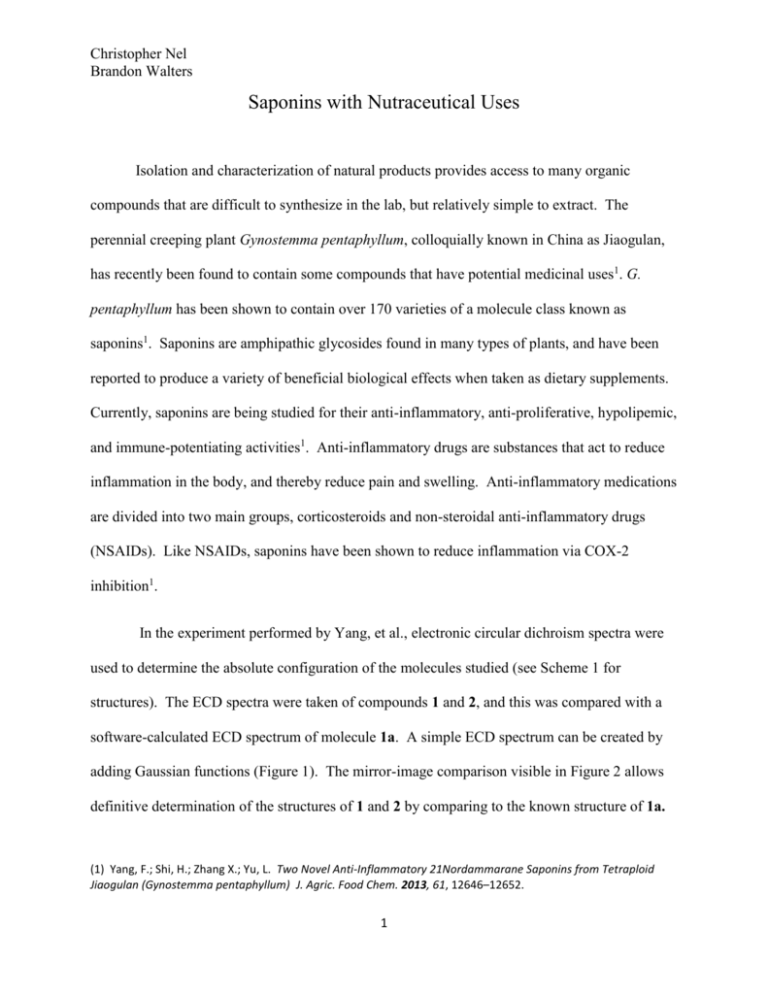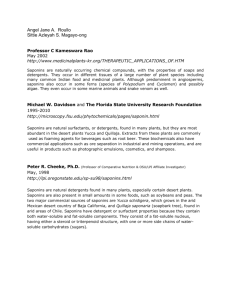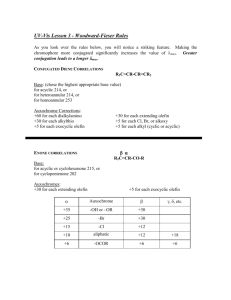DOCX
advertisement

Christopher Nel Brandon Walters Saponins with Nutraceutical Uses Isolation and characterization of natural products provides access to many organic compounds that are difficult to synthesize in the lab, but relatively simple to extract. The perennial creeping plant Gynostemma pentaphyllum, colloquially known in China as Jiaogulan, has recently been found to contain some compounds that have potential medicinal uses1. G. pentaphyllum has been shown to contain over 170 varieties of a molecule class known as saponins1. Saponins are amphipathic glycosides found in many types of plants, and have been reported to produce a variety of beneficial biological effects when taken as dietary supplements. Currently, saponins are being studied for their anti-inflammatory, anti-proliferative, hypolipemic, and immune-potentiating activities1. Anti-inflammatory drugs are substances that act to reduce inflammation in the body, and thereby reduce pain and swelling. Anti-inflammatory medications are divided into two main groups, corticosteroids and non-steroidal anti-inflammatory drugs (NSAIDs). Like NSAIDs, saponins have been shown to reduce inflammation via COX-2 inhibition1. In the experiment performed by Yang, et al., electronic circular dichroism spectra were used to determine the absolute configuration of the molecules studied (see Scheme 1 for structures). The ECD spectra were taken of compounds 1 and 2, and this was compared with a software-calculated ECD spectrum of molecule 1a. A simple ECD spectrum can be created by adding Gaussian functions (Figure 1). The mirror-image comparison visible in Figure 2 allows definitive determination of the structures of 1 and 2 by comparing to the known structure of 1a. (1) Yang, F.; Shi, H.; Zhang X.; Yu, L. Two Novel Anti-Inflammatory 21Nordammarane Saponins from Tetraploid Jiaogulan (Gynostemma pentaphyllum) J. Agric. Food Chem. 2013, 61, 12646–12652. 1 Christopher Nel Brandon Walters Scheme 1. Structures of Saponin Compounds 2 Christopher Nel Brandon Walters 12 Δε (M-1 cm-1) 8 4 Function 1 0 Function 2 ECD Spectrum -4 -8 -12 200 250 300 350 400 Wavelength (nm) 𝑖=2 −(𝜆−𝜆𝑚𝑎𝑥 )2 ℎ 1 2𝜎2 𝑓(𝜆, 𝟏𝒂. ) = ∑ 𝑓𝑖 (𝜆), 𝑤ℎ𝑒𝑟𝑒 𝑓𝑖 (𝜆) = 𝑒 𝑛 √2𝜋𝜎 2 𝑖=1 Function 1 Position: λmax, 1 = 275 nm Width: σ1 = 20 nm Height: h1 = -1 Normation: n1 = 0.0199 Function 2 Position: λmax, 2 = 305 nm Width: σ2 = 20 nm Height: h2 = -4 Normation: n1 = 0.0199 Figure 1. ECD spectrum of 1a constructed by superposition of two Gaussian functions. 3 Christopher Nel Brandon Walters Experimental ECD of 1 in MeOH Experimental ECD of 2 in MeOH Calculated ECD of 1a in MeOH 12 8 Δε (M-1 cm-1) 4 0 -4 -8 -12 200 250 300 350 400 Wavelength (nm) 𝑖=𝑚 𝑓(𝜆, 𝑵) = ∑ 𝑓𝑖 (𝜆), 𝑤ℎ𝑒𝑟𝑒 𝑓𝑖 (𝜆) = 𝑖=1 −(𝜆−𝜆𝑚𝑎𝑥 )2 ℎ 1 2𝜎2 𝑒 𝑛 √2𝜋𝜎 2 For N = 1a (λmax,m [nm], m [nm], hm, nm): 275, 20, 1, 0.0199 (m = 1); 305, 20, -4.0, 0.0199 (m = 2). For N = 1: (λmax,m [nm], m [nm], hm, nm): 200 , 8, 16, 0.0499 (m = 1); 208, 10, -13, 0.0391 (m = 2); 216, 8, 9, 0.0495 (m = 3); 255, 12, -0.7, 0.0332 (m = 4); 289. 6.5, 4, 0.0607 (m = 5); 307, 9, 9, 0.0432 (m = 6); 325, 8, 5, 0.0499 (m = 7); 360, 20, -0.5, 0.0199. For N= 2 (λmax,m [nm], m [nm], hm, nm): 160, 13, -10, 0.0003 (m = 1); 210, 4.5, 3, 0.0887 (m = 2); 223, 5, 1.5, 0.0737 (m = 3); 255, 10, -0.65, 0.0399 (m = 4); 296, 10, 3.5, 0.0397 (m = 5); 308, 6, 4, 0.0629 (m = 6); 320, 8, 4, 0.0499 (m = 7); 370, 20, -0.5, 0.0199 (m = 8). Figure 2. Comparison of experimental ECD spectra from 1 and 2 to calculated spectrum of 1a. 4









